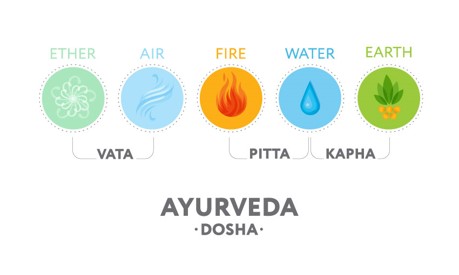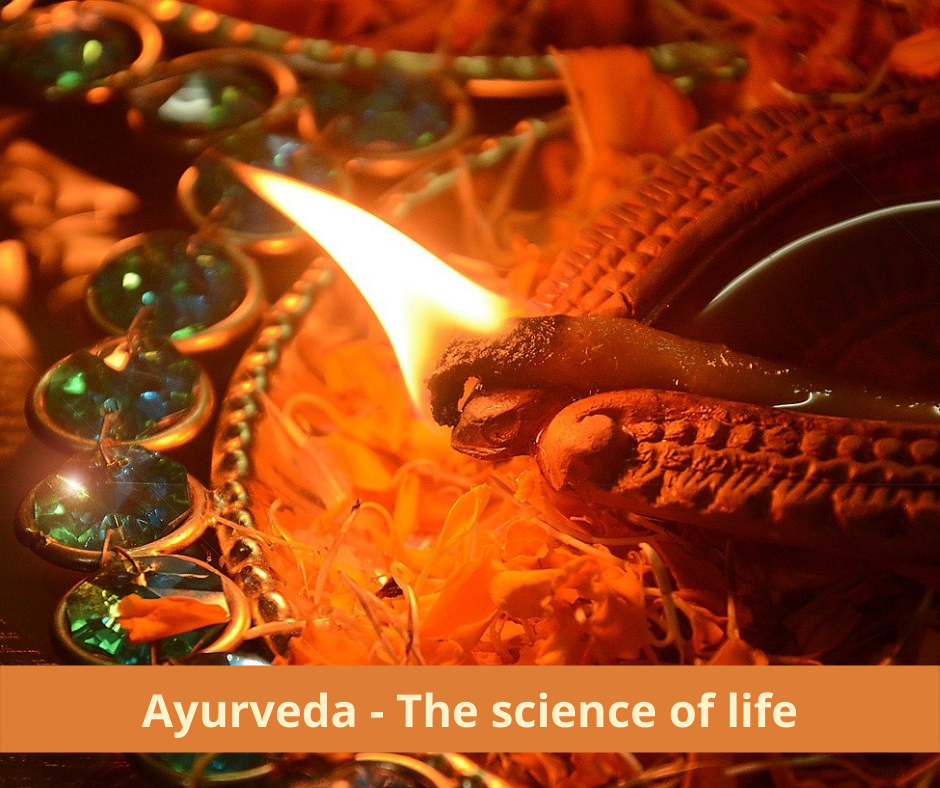

Ayurveda views the human body in terms of conscience, of information and energy as being contained within a physical field of organs, tissues and channels.
Yoga considers asanas like static poses with energy conditions, which in turn are manifestations of consciousness.
The body is not simply physical, but it is only a point of physical concentration of forces which extend to the whole universe.
The physical body itself is mortal, and connected to larger energies and powers of immortality and eternity.
Although limited in size, its connections extend endlessly.
The Ayurvedic effects of the practice of asanas
According to the philosophy of yoga, the physical body is:
• manifestation of consciousness.
• a crystallization of karmic (behavioral) patterns created by the mind.
The key to working with the body is to understand the consciousness behind it, much of which lies outside of our ordinary consciousness.
• Mindful asana practice
• Not only the technical aspects of the postures,
• But also of the mental and emotional states they create in us.
Ayurveda considers the body as a manifestation
• doshas physical energies,
• pranic and psychological energies, factors of consciousness.
We can not examine the doshic impact of asanas only on a physical level, but we must also consider their psychological effects.
The energy and focus we put into the pose is as important as the pose itself.
We can see this in ordinary life in which what we feel on a psychological level determines how we move on a physical level.
The long-term patterns of sensations and energy determine the shape and rhythm of the body.
Each asana has its own structural effect.


The seated postures provide:
• the stability of the spine
• create flexibility in the back of the legs.
• create parasympathetic stimulation,
=> they create a pleasant calming influence.
Standing poses increase overall strength and energy levels.
Backbends tend to:
• excite us (sympathetic stimulation),
• to increase the extension of the spine and to create strength in the erector muscles of the trunk.
• Relaxation poses even out and calm the energies created by our asana practice.
All asanas, whether in groups or individually, have their own energy depending on what they do to the body.
The experience of an asana will vary depending on
• of the constitution,
• flexibility and the organic condition of the individual.
The effect of the asana is the combination of the structure of the asana, the same for everyone, and the person’s own body structure
• which not only varies from one individual to another,
• but also changes over time.
Asana as Pranic Energy
The physical body is a vehicle for our internal energies defined by Prana.
Asanas are vehicles through which Prana is directed.
An asana is not just a physical structure but an energy condition
The asana is like a car with Prana as its driving force.
It’s not just about having the right vehicle, it’s also about moving it the right way.
The Pranic impulse behind the asana is as important as the asana itself
This means that depending on how we direct our Prana, the same asana can take us to different places.
For example, a seated posture done with strong pranayama can have a very energizing effect, while with ordinary breathing it will calm us down or even put us to sleep.
Asana is not only structure and energy, but also reflects thought and the intention.
We could call asana a “reflective” or “mindful” form of exercise.
The effects of the same asana will vary depending on whether our mind is clear or cloudy and our emotions are calm or turbulent
Ayurvedic effects of asanas
Each asana has a particular effect in relation to the three doshas.


This is the same as how Ayurveda classifies foods according to their doshic effects as good or bad for Vata, Pitta and Kapha, depending on the tastes and elements that make up each food.
Asanas = structural capacity =. to increase or decrease the doshas.
Through the use of the breath, we can modify or even change the doshic effects of the asana.
And the importance of thought and intention in asana practice.
Asana + prana + mind = modifying a particular asana or adjusting the whole practice towards a particular doshic result.
Specific asanas + pranayama + meditation = complete internal balance can be created and maintained.
The doshic application of asanas is two fold
• According to the constitution of the individual defined by his doshic type as Vata, Pitta and Kapha and their mixtures.
• Relating to the impact of asanas on the doshas as general physiological functions.
Each dosha has its sites and actions in the body which the asanas will perform depending on their orientation.
Why Yoga practice should start with Ayurveda


Ayurveda with Yoga helps us gain:
• complete harmony and balance in body and mind
• so that we can discover our true Self which is one with all.
Yoga is practiced today for health benefits as the main factor
• asanas and pranayama,
• sometimes extending to mantra, mindfulness and meditation to improve our psychological well-being.
What we may not know is that the healing aspect of yoga is traditionally based on Ayurveda,
India’s ancient natural healing system developed from the philosophy of yoga and Vedic knowledge as a medical application.
These two Vedic disciplines rely on each other, Ayurveda being the healing aspect of Yoga.
Yoga was originally conceived as the Vedic tradition of sadhana to promote Self-realization through mind control, as in the teachings of the Yoga Sutras of Rishi Patanjali and the Bhagavad Gita of Sri Krishna.
Ayurveda was conceived as the Vedic tradition of healing and wellness for body and mind, as described in the Charaka Samhita and the Sushruta Samhita, the two oldest Ayurvedic texts.
over time, the two systems have undergone their own developments and diversifications, so many people, including yoga teachers, may not understand their links or how to use them together.
Ayurveda, like traditional yoga, views the universe in terms of two factors:
• of Purusha – the consciousness principle or Higher Self,
• and Prakriti – the force of nature which governs all organic processes.
Ayurveda extends the principles of yoga philosophy and cosmology to the functioning of body and mind to bring them to optimal function and harmony.
Yoga and Ayurveda share the Vedic sciences:


• of the five elements,
• of the five pranas,
• the spirit and the gunas (qualities of nature)
• and many other related factors.
Ayurveda like Yoga emphasizes the Atman or Higher Self as the ultimate repository of health and well-being.
Each of us has a unique body-mind constitution, just as we have our own specific personal karmas to deal with in life.
No two people are exactly the same and therefore we must treat each individual differently according to their nature.
We can’t just take mass prescriptions and get cured, but we have to meet each person’s needs which may be radically different from each other.
– understand how the three doshas work in us
– of Vata (air and ether),
– Pitta (fire) and Kapha (water and earth)
These constitute our individual doshic prakriti or “mind-body type”,
Prakriti determines our particular needs in matters of:
• food,
• herbs,
• exercise and lifestyle,
• as well as our general tendency to illness.
The three gunas
In approaching the mind, we must understand how the three gunas affect the workings of the mind:
• of sattva (balance), rajas (aggression) and tamas (inertia)
According to Ayurveda, the gunas of rajas and tamas, which cause restlessness or boredom, are the disease-causing factors or doshas at the level of the mind that must be eliminated for emotional happiness and peace of mind.
Yoga = development of sattva guna in the mind for mental acuity and as a foundation for meditation.
Yamas and Niyamas of Yoga are the principles of the sattvic life.
These 2 systems are the understanding of our individual constitution according to Ayurveda in order to help guide our practice of Yoga.
Ayurveda helps to put:
• our yoga practice on a solid foundation,
• how to take care of our unique constitution through the three doshas and their variations in us and around us.
• help determine which yoga practices are best for us, from asanas to meditation.
Ayurveda helps us to understand the state of Agni or our biological fires,
• by the digestive fire (jatharagni)
• by extending to the pranic fire or the fire of the breath,
• in the fire of the mind
• and finally to the fire of awareness that arises in deep meditation.
Higher yoga practices involve:
• to balance and develop the different levels of Agni
• offer enhanced levels of perception and consciousness – through Yogagni or the fire of Yoga.
What is the Fire of Yoga?
Benevolent/beneficial elements obtained through the practice of inner meditation, the elements by which all bonds born of illusion, including those of the practitioner’s body, are reduced to ashes.
Ayurveda details understanding of Prana and its five sub-types which govern the movement of energy in body and mind.
Yoga asanas are manifestations of the five pranas
• Udana or upward movement,
• Apana or downward movement,
• Vyana or expansive movement and Samana or contraction movement,
• Prana being overall increased energy.
Ayurveda as a complete system of yogic medicine
Ayurveda = complete system of yogic medicine
• understanding of body and mind,
• determining the individual constitution,
• disease theory and diagnostic methods,
• and treatment methods that include diet, herbs, massage and Pancha Karma.
Embraces all aspects of Yoga and meditation
• his psychological therapies.
Ayurveda stems from the Samkhya-Yoga philosophy and its principles rooted in
• the Purusha, the Higher Self which is the goal of Yoga practice.
Ayurveda recommends specific health regimens
• at the individual level,
• including daily practices,
• monthly and seasonal,
• and practices relating to the stage of life, from infancy to old age.
Yogic healing works best within the context of a complete yogic system of medicine provided by Ayurveda.
Using Ayurveda with yoga helps us achieve complete harmony and balance in body and mind so that we can discover our true Self which is one with all.
All yoga teachers should learn the basics of Ayurveda and all yoga students should seek Ayurvedic guidance to enhance their yoga practice.
References
https://www.ncbi.nlm.nih.gov/pmc/articles/PMC6892000/
https://www.ncbi.nlm.nih.gov/pmc/articles/PMC9034459/
https://www.ncbi.nlm.nih.gov/pmc/articles/PMC5294833/
https://www.ncbi.nlm.nih.gov/pmc/articles/PMC6542302/
https://www.ncbi.nlm.nih.gov/pmc/articles/PMC5481961/
https://www.ncbi.nlm.nih.gov/pmc/articles/PMC8303653/
https://www.ncbi.nlm.nih.gov/pmc/articles/PMC6083945/
